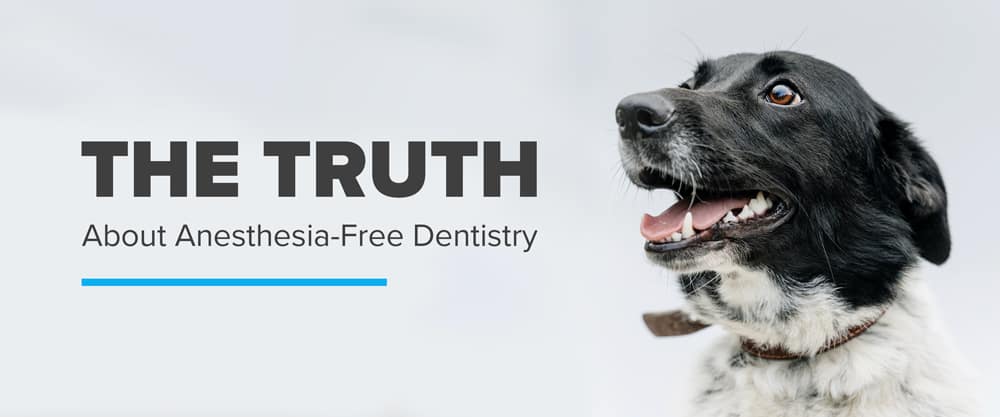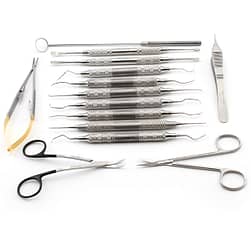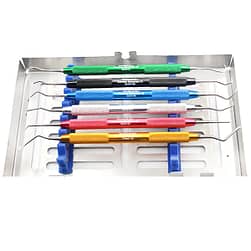
In some areas of the country, pet owners are solicited with advertisements for anesthesia-free dentistry on a nearly daily basis. This service is increasingly being marketed by groomers, pet stores, and even veterinary clinics as a safe, affordable alternative to traditional veterinary dentistry. When clients elect anesthesia-free dentistry over traditional veterinary dentistry, however, they may not be getting the best value for their hard-earned money and they may be placing their pets at risk. All veterinary team members need to understand the risks and limitations of anesthesia-free dentistry, so they can effectively educate clients about these services.
The Truth About Anesthesia-Free Dentistry
Individuals who promote anesthesia-free dentistry often claim that is relatively comparable to veterinary dentistry, without the risks that accompany general anesthesia. Unfortunately, these claims are misleading.
Anesthesia-free dentistry only addresses visible tartar above the gumline. There is no way to remove tartar from below the gumline on an awake pet, and this tartar is the largest contributor to periodontal disease. Therefore, anesthesia-free dentistry is purely a cosmetic treatment, with little benefit in preventing periodontal disease.
Realistically, even tartar above the gumline is unlikely to be fully removed in an awake pet. Most pets will only remain still for a few minutes with restraint. As we all know, a thorough dental cleaning often takes half an hour or more, even on a completely stationary and anesthetized patient. It would be nearly impossible to perform a thorough above-the-gumline dental cleaning on an awake pet using only manual restraint, even if we were to determine that the obvious limitation of not addressing bacteria below the gumline is acceptable.
Anesthesia-free dentistry is often performed by individuals who are not adequately trained to recognize dental pathology or other relevant conditions.1 Clients may leave their pet’s anesthesia-free dental cleaning feeling their pet has received appropriate medical care when, in fact, the individual performing anesthesia-free dentistry has no training in how to recognize dental pathology or other oral health concerns. This can lead to a delay in diagnosing and treating pathologic conditions.
Anesthesia-free dentistry addresses only a single component of what is typically involved in a veterinary dental cleaning: the scaling of teeth. When a pet is awake, and the services are provided by individuals without adequate dental training, the ability to provide thorough dental probing, charting, and radiographs are severely limited. Arguably, the diagnostic aspect of veterinary dentistry is even more valuable than the removal of tartar, meaning that patients who receive anesthesia-free dentistry miss out on some of the most valuable benefits of dentistry.
Anesthesia-free dentistry also is not without significant risks. According to the 2005 American Veterinary Dental College statement on Companion Animal Dental Scaling Without Anesthesia, “even slight head movement by the patient could result in injury to the oral tissues of the patient.”1 Removing tartar from the tooth surface requires the use of very sharp instruments and/or ultrasonic scalers. Having these instruments in the mouth of an unanesthetized patient presents a significant risk of injury. Additionally, the lack of a cuffed, inflated endotracheal tube during dentistry places these patients at heightened risk of aspiration pneumonia.
Finally, anesthesia-free dentistry is often stressful for patients. Few patients will sit calmly while a variety of instruments are introduced into their mouths. Even those patients who are generally cooperative likely experience some degree of stress during this procedure. In contrast, general anesthesia allows a dental cleaning to be performed in a manner that is far less stressful to the patient.
Addressing Client Concerns About Veterinary Dentistry
The primary factors that steer clients towards anesthesia-free dentistry are anesthetic concerns and financial considerations. While it is important to talk to clients about how veterinary dentistry is superior to anesthesia-free dentistry, it is perhaps even more important to address their concerns about anesthesia and finances.
Most clients overestimate the risks associated with anesthesia in veterinary patients and opt for anesthesia-free dentistry because they mistakenly perceive it as being a lower-risk option. While any anesthesia-associated death is one too many, current studies estimate the risk of death during and in the days after anesthesia as approximately 1 in 600 for dogs and 1 in 400 for cats.2 Many of those pets who experience anesthetic complications were already compromised, to begin with (perhaps they were undergoing emergency surgery for serious medical concern or trauma), meaning that the risk is likely lower in stable pets with a low ASA status. Help your clients think through their pet’s risk factors. Emphasize your practice’s anesthetic safety protocols, such as pre-anesthetic bloodwork, intravenous catheter placement, and anesthetic monitoring procedures. Address client concerns about anesthesia head-on, so your client can make an educated decision for their pet.
Next, you must talk about financial considerations. When talking to clients about the cost of appropriate veterinary dentistry, it is important to highlight that comparing anesthesia-free dentistry to veterinary dentistry is like comparing apples to oranges. Yes, anesthesia-free dentistry often costs less, but the patient and client miss out on many of the benefits that are afforded by appropriate veterinary dentistry. While the cost of anesthesia-free dentistry may be less than the cost of veterinary dentistry, money spent on anesthesia-free dentistry is essentially being “thrown away.” Regular dental cleanings are a valuable component of preventative veterinary care, but anesthesia-free dentistry does not offer similar benefits. Therefore, while the cost of a veterinary dental cleaning may be higher than anesthesia-free dentistry, the value of traditional veterinary dentistry is far higher.3 Talk to clients about payment options (such as CareCredit, if offered by your practice) that can help put appropriate veterinary dentistry within financial reach for them.
Clients with financial constraints may also benefit significantly from appropriate dental home care. Instead of paying for anesthesia-free dentistry for six months, perhaps they could implement daily toothbrushing at home and then opt for veterinary dentistry on an annual basis. This would offer greater health benefits for their pet, while also helping to control costs.
Work With Clients, Not Against Them
When clients turn to anesthesia-free dentistry, everyone loses (except for the providers of those services). The pet loses appropriate dental care, the client loses by spending money on a service of minimal benefit, and you lose a chance to offer quality care for your patient. Therefore, it is important to work with clients to help them see the value of veterinary dentistry. By showing them what is missing in anesthesia-free dentistry, as well as the risks associated with services, you can improve the likelihood of your patient receiving high-quality care.
References
- American Veterinary Dental College. (2004). Companion Animal Dental Scaling Without Anesthesia. Retrieved from: https://avdc.org/PDF/Dental_Scaling_Without_Anesthesia.pdf
- Portier, K., & Ida, K. K. (2020). Editorial: Anesthetic Risk and Complications in Veterinary Medicine. Frontiers in veterinary science, 7, 397. Retrieved from: https://www.frontiersin.org/articles/10.3389/fvets.2020.00397/full
- American Veterinary Dental College. Are Anesthesia-Free Dental Cleanings Really Cheaper? Retrieved from: https://afd.avdc.org/are-anesthesia-free-dental-cleanings-really-cheaper/
Dr. Catherine Barnette, DVM
Related Products
-

GDN Periodontal Surgery Set
-

Color Coated Aluminum Handle Periodontal Kit
-

Periodontal Instrument Set
-

ECG Esophageal with Temperature 24/2
-

Penlon Sigma Delta Vaporizer
-

Moduflex Neoprene Reusable Rebreathing Bag
-

HIGHDENT Quattro Plus Veterinary Dental Unit
-

LifeWindow One Monitor
-

HTP-1500 Heat Therapy Pump
-

SpO2 Sensor For Vital Sign Monitor
Rated 5.00 out of 5 -

Universal Ultrasonic Inserts
-

Bluetooth Dental Scissor Table Vet-Tables
-

Piezo Scaler Handpiece
-

Patient Circuit Alarm
-

Moduflex Bain Circuit Adaptor
-

Moduflex Coaxial veterinary anesthesia machine





